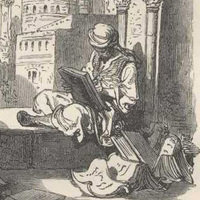articles by Stefania Pastore
in The Expulsion of the Moriscos from Spain. A Mediterranean Diaspora, eds. M. García-Arenal and... more in The Expulsion of the Moriscos from Spain. A Mediterranean Diaspora, eds. M. García-Arenal and G.Wiegers, Leiden-Boston, Brill, 2014, pp. 132-154
in A Companion to Ignatius of Loyola. Life, Writings, Spirituality, Influence, ed. R.A. Maryks, L... more in A Companion to Ignatius of Loyola. Life, Writings, Spirituality, Influence, ed. R.A. Maryks, Leiden-Boston, Brill, 2014, ch. 3, pp. 25-44
In: Visions, Prophecies and Divinations: Early Modern Messianism and Millenarianism in Iberian Am... more In: Visions, Prophecies and Divinations: Early Modern Messianism and Millenarianism in Iberian America, Spain and Portugal, ed. A. P. Torres Megiani – L. F. Silvério Lima, Leiden-Boston, Brill, 2016
c o n v e r s o m e m o r y i n t o l e d o stefania Pastore scuol a normale superiore di pisa la... more c o n v e r s o m e m o r y i n t o l e d o stefania Pastore scuol a normale superiore di pisa la corÓnica 41.1 Fall 2012 235-62
L’Inquisizione e gli storici: un cantiere aperto, Roma, Accademia Nazionale dei Lincei, 2000, pp. 109-146
Books by Stefania Pastore
Il volume esplora l'affascinante e raffinato mondo ereticale spagnolo seguendo otto itinerari ind... more Il volume esplora l'affascinante e raffinato mondo ereticale spagnolo seguendo otto itinerari individuali di personaggi, più o meno noti, caduti nelle reti dell'Inquisizione. Attraverso scritti e processi inquisitoriali spesso inediti si delineano affinità e percorsi comuni all'interno di quell'eclettica e dirompente eresia spagnola cresciuta tra i conversos del Quattrocento, maturata negli ambienti di alumbrados della Spagna degli anni Venti-Trenta e fatta conoscere in Europa attraverso le straordinarie esperienze di Juan de Valdés e Miguel Servet.

This volume explores how the relationship between confraternities and the clergy negotiated the b... more This volume explores how the relationship between confraternities and the clergy negotiated the boundaries of religious space in the late medieval and early modern periods.
Who owns the spaces of religion? Does the question matter, or even make sense? Modern distinctions between sacred and secular spheres tend to assume that clergy dominate the former, and lay people the latter. A man or woman living in the early modern period might not have been so sure. They would have thought more immediately of things of heaven and things of earth, and would have seen each as the concern of clergy and laity alike. Faith’s boundaries, while real, were very porous. This collection offers the first sustained comparative examination of lay–clerical relations in confraternities through the late medieval and early modern periods. It shows how laity and clergy debated, accommodated, resolved, or deflected the key issues of gender, race, politics, class, and power. The sixteen essays are organized into six sections that consider different aspects of the function of confraternities as social spaces where laity and clergy met, mediated, and sometimes competed and fought. They cover a period historically when kinship was a dominant metaphor in religious life and when kinship groups like confraternities were dominant models in religious institutions. They deal with Catholic, Jewish, and Islamic confraternities, and range geographically from Europe to the Middle East, Central and South Asia, and Latin America.

Un filo rosso lega i saggi pubblicati in questo libro di John Tedeschi, noto studioso dell’Inquis... more Un filo rosso lega i saggi pubblicati in questo libro di John Tedeschi, noto studioso dell’Inquisizione romana; li lega tra di loro e allo stesso tempo li riconduce in modo suggestivo alla vicenda biografica del loro autore: il tema dell’esilio. Esuli sono gli eretici italiani del Cinquecento protagonisti di gran parte dei contributi che compongono la seconda parte di questo libro, costretti a lasciare la penisola italiana per motivi religiosi, stanchi di dissimulare l’adesione a dottrine religiose ormai condannate dagli organi repressivi romani e ansiosi di trovare nuove patrie disposte ad accogliere le proprie famiglie e ad ascoltare le proprie idee, diffondendo così nel nord Europa il meglio della cultura rinascimentale italiana. Esuli sono alcuni degli intellettuali, come Paul Oskar Kristeller, che animano la terza ed ultima sezione del volume, forzatamente indotti ad abbandonare l’Italia, patria di studi umanistici e filologici, dalla sciagurata legislazione antiebraica, ultimo pegno pagato dall’Italia mussoliniana all’infausta alleanza nazi-fascista, pronti ad attraversare l’oceano per trovare accoglienza nel più sicuro continente americano. Esule, infine, l’autore del volume, costretto ad abbandonare insieme alla propria famiglia la città di Ferrara alla tenera età di otto anni per trasferirsi negli Stati Uniti, destinato a diventare anch’egli un famoso intellettuale in esilio, proprio come i protagonisti di molti dei suoi studi qui finalmente raccolti.
Book Reviews by Stefania Pastore
Renaissance Quarterly, Vol. 59, No. 2 (Summer, 2006), pp. 544-546.











Uploads
articles by Stefania Pastore
Books by Stefania Pastore
Who owns the spaces of religion? Does the question matter, or even make sense? Modern distinctions between sacred and secular spheres tend to assume that clergy dominate the former, and lay people the latter. A man or woman living in the early modern period might not have been so sure. They would have thought more immediately of things of heaven and things of earth, and would have seen each as the concern of clergy and laity alike. Faith’s boundaries, while real, were very porous. This collection offers the first sustained comparative examination of lay–clerical relations in confraternities through the late medieval and early modern periods. It shows how laity and clergy debated, accommodated, resolved, or deflected the key issues of gender, race, politics, class, and power. The sixteen essays are organized into six sections that consider different aspects of the function of confraternities as social spaces where laity and clergy met, mediated, and sometimes competed and fought. They cover a period historically when kinship was a dominant metaphor in religious life and when kinship groups like confraternities were dominant models in religious institutions. They deal with Catholic, Jewish, and Islamic confraternities, and range geographically from Europe to the Middle East, Central and South Asia, and Latin America.
Book Reviews by Stefania Pastore
Who owns the spaces of religion? Does the question matter, or even make sense? Modern distinctions between sacred and secular spheres tend to assume that clergy dominate the former, and lay people the latter. A man or woman living in the early modern period might not have been so sure. They would have thought more immediately of things of heaven and things of earth, and would have seen each as the concern of clergy and laity alike. Faith’s boundaries, while real, were very porous. This collection offers the first sustained comparative examination of lay–clerical relations in confraternities through the late medieval and early modern periods. It shows how laity and clergy debated, accommodated, resolved, or deflected the key issues of gender, race, politics, class, and power. The sixteen essays are organized into six sections that consider different aspects of the function of confraternities as social spaces where laity and clergy met, mediated, and sometimes competed and fought. They cover a period historically when kinship was a dominant metaphor in religious life and when kinship groups like confraternities were dominant models in religious institutions. They deal with Catholic, Jewish, and Islamic confraternities, and range geographically from Europe to the Middle East, Central and South Asia, and Latin America.
1. El Nuevo Mundo y las inquietudes apocalípticas en el siglo XVI italiano (Adriano Prosperi)
2. Profecía, conversión y polémica islamo-cristiana en la Iberia alto-moderna (siglo XV): Alfonso de Jaén y el círculo del obispo don Martín García (Mònica Colominas Aparicio)
3. Migraciones y expectativas mesiánicas. Giorgio Benigno Salviati, el monje Teodoro y Paolo Angelo en la Italia del Renacimiento (Michele Lodone)
4. Profetizar la reforma. Paolo Angelo y el Apocalypsis Nova (Eduardo Fernández Guerrero)
5. Pedro González de Mendoza, de Toledo a Roma. El patronazgo de Santa Croce in Gerusalemme entre la arqueología y la filología (Felipe Pereda)
6. Sebastiano del Piombo y las fuentes de la Capilla Borgherini: Pietro Galatino, Egidio da Viterbo y el Apocalypsis Nova (Stefania Pasti)
7. Nemo crucis titulos tam convenienter habebat quam tu. Entre profecía y devoción: símbolos e imágenes en el programa religioso y político de Bernardino López de Carvajal (Edoardo Rossetti)
8. Las revelaciones de Arcangela Panigarola: entre profetismo y devoción (Corinna T. Gallori)
9. La Imago Pietatis de Santa Croce in Gerusalemme, el papa Gregorio Magno y España (Jack Freiberg)
10. El mito de las Tribus Perdidas entre España, Europa y el Nuevo Mundo (Marco Volpato)
11. Campanella y el Islam (Michele Olivari)
Bibliografía
Índice analítico